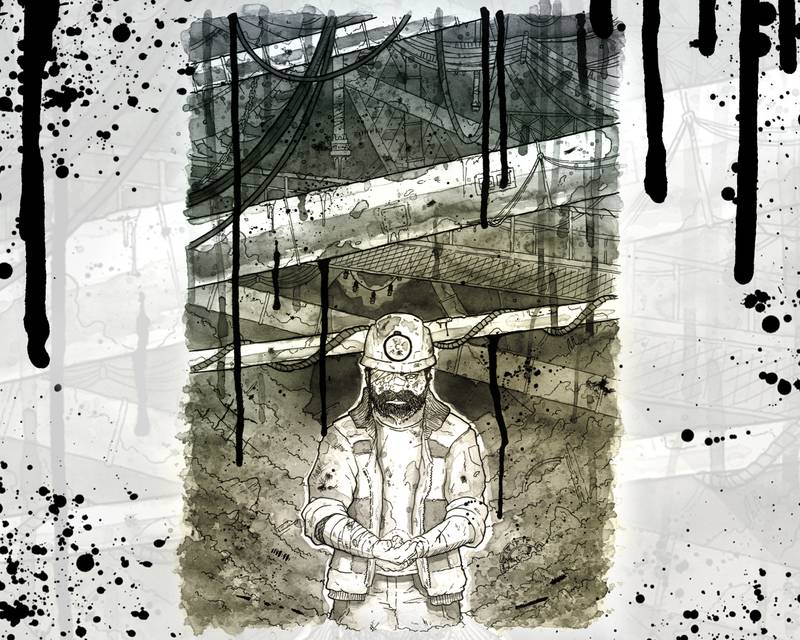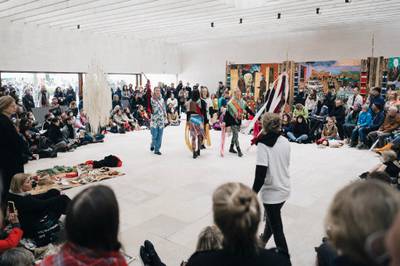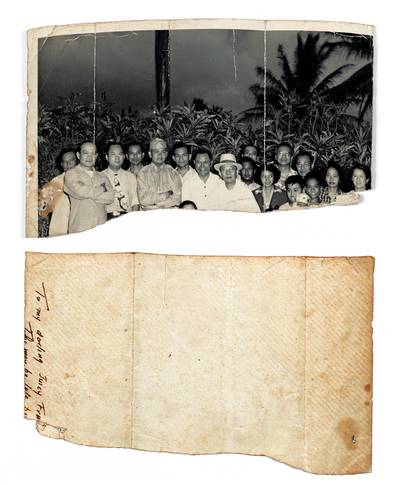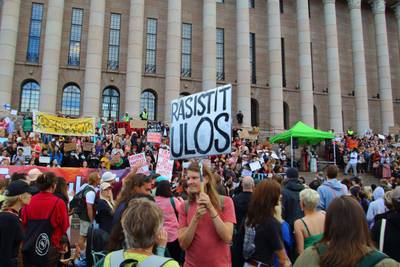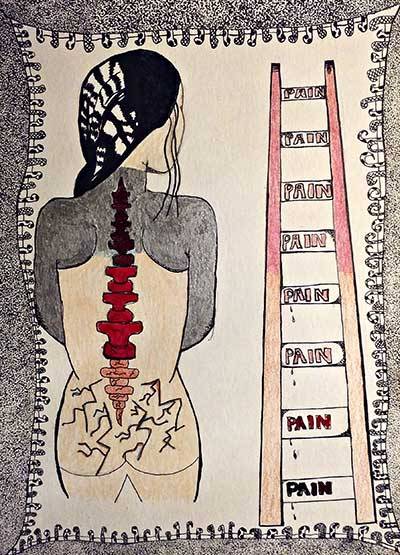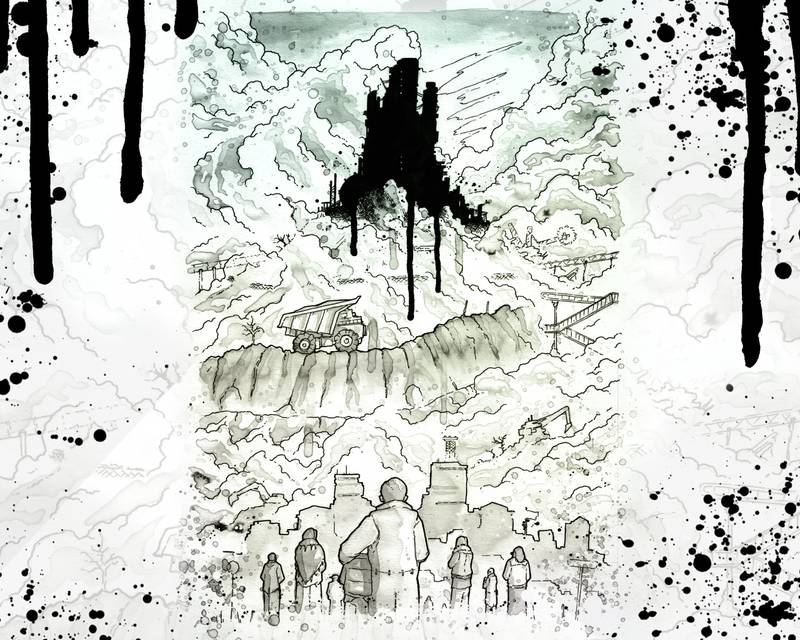

Anna Varfolomeeva is a postdoctoral researcher at Helsinki Institute of Sustainability Science (HELSUS) and Faculty of Arts, University of Helsinki. Her current project focuses on indigenous notions of sustainability in industrialized areas of the Russian North and Siberia. Anna received her PhD at Central European University in Budapest and previously worked at the School of Advanced Studies, the University of Tyumen in Siberia. She is the co-editor of Multispecies Households in the Saian Mountains: Ecology at Russia-Mongolia Border (with Alex Oehler, 2019).
This essay addresses the paradoxical parallels between more-than-human care and self-destruction in the realm of heavy industries. Through everyday engagement with industrial materials and machines, workers often develop strong attachment and a sense of pride towards industries. However, increased care about the industry may influence workers’ estrangement from their bodily needs. As a result, they start prioritizing productivity over their health and well-being. I define intertwined relations of industrial attachment and self-damage as “destructive care.” This notion encompasses the potentially harmful effects of caring attitudes in industrial settings.
To analyze the problem of destructive care, I discuss the example of Veps, an indigenous ethnic minority residing in Karelia, Northwestern Russia, along the shores of Lake Onega and not far from the Russian-Finnish border. This analysis is based on my ethnographic fieldwork conducted in Karelia in several instalments between 2015 and 2021. Due to the long-term tradition of decorative stone mining, Veps in Karelia have developed strong connections with stone that symbolically dominates their villages’ landscapes and the workers’ life cycles. In Veps villages, the strong emotional attachment of mining workers towards stone influences local visions of health risks and environmental damage associated with mining.
The world of care
Care is a multifaceted notion: it rather paradoxically brings together abstract ethical dilemmas and practical orientation, intimate encounters and attention to global challenges (Ureta, 2016). The acts of providing care are often associated with strong emotional attitudes. However, it is important to note that acts of care are not necessarily associated with positive feelings and emotions. As Maria Puig de la Bellacasa (2017) points out, the visions of care as “warm pleasant affection or a moralistic feel-good attitude” are often contested. Practices of care may also have negative impacts and result in feelings of fear, worry, or disappointment. Interestingly, the concepts of care and concern are related etymologically, both having their roots in the Latin word cura (Puig de la Bellacasa, 2011). These parallels between care and concern could be instrumental in understanding the diverse emotions accompanying caring practices. Besides, caring relations are strongly influenced by unequal power distributions in the society and may themselves become means of exercising power (Martin et al., 2015). In this sense, widely recognized practices of care such as humanitarian assistance, geriatric nursing, or coronavirus tracking instruments, are strongly linked with control and surveillance, or with states or institutions exercising normative power over citizens (Biehl, 2012; Miller, 2020; Sahraoui, 2020). As Thorn van Dooren (2014) points out, practices of care aimed at certain individuals and species may simultaneously cause suffering or even death for others. Therefore, when discussing care in more-than-human contexts, it is important to keep asking who decides how and when to exercise care, as well as who is included in caregiving or excluded from it.
There are multiple cases when acts of care, take the form of routine mundane practices, and when self-care practices are phrased in the form of “operation manuals,” such as hand washing for at least twenty seconds or observing a two-meter distance during the pandemic. In such situations, care is viewed as a routine practice of mending fragmented social life elements, similarly to maintenance and repair of mechanisms.
It may seem that care is always loaded with emotions, either warm or pleasant ones or “darker” negative feelings. Could we, however, envision a notion of care where its emotional constituent is blurred? There are multiple cases when acts of care, take the form of routine mundane practices, and when self-care practices are phrased in the form of “operation manuals,” such as hand washing for at least twenty seconds or observing a two-meter distance during the pandemic. In such situations, care is viewed as a routine practice of mending fragmented social life elements, similarly to maintenance and repair of mechanisms. In this essay, I simultaneously discuss emotionally loaded more-than-human care expanded towards materials and industries and emotionally deficient self-care of productive workers’ bodies.
Today, the concept of care is increasingly discussed in more-than-human contexts (see, for example, Martin et al., 2015; Puig de la Bellacasa, 2015; Schrader, 2015). However, at the same time, the concept of care is rarely applied towards heavy industries. At the same time, as the example of Veps mining workers demonstrates, direct engagement with industrial materials and machines may result in a feeling of deep attachment towards the industry. In the case of Veps, industrial productivity is strongly associated with the workers’ self-respect and self-pride as skilled producers of valuable resources. Current and former mining workers refer to the mining industry with strong emotions of affection, pride, fear, anxiety, or disappointment. Simultaneously, they talk about their bodily practices and experiences with estranged and alienated attitudes. Bodies get sacrificed for the sake of industry when needed, they get damaged as a result of working with stone or become exposed to higher risk when productivity is at stake. By extending the notion of care to industrial materials and machines, Veps mining workers in many cases become neglectful or inattentive towards their well-being. Through mutual influence, the relations between humans and machines become blurred, nuanced, and unsettling.
Care and concern about industries
Natural resource extraction brings humans, materials, and machines together by forming strong and lasting connections. Through engaging with resources, miners’ identities are formed and articulated. As humans are changing the previously unknown substances creating resources, the materials influence them back damaging their bodies or causing emotional reactions of pride, affection, worry, fear, or disenchantment. Therefore, natural resources are not mere participants in social relations; they also produce new social configurations, as it happened in the case of Veps.
Since the 18th – 19th centuries, Veps in Karelia have been managing the extraction of rare decorative stones, gabbro-diabase, and raspberry quartzite. Both stones are also referred to simply as “diabase” and “quartzite,” or as “the stone” collectively, sometimes specified as “the grey stone” for diabase and “the red stone” for quartzite. Diabase and quartzite have been widely used for monument construction and building decoration. One of their most famous destinations is the Red Square ensemble in Moscow: the square’s pavement is made out of grey Karelian diabase, while parts of Lenin’s Mausoleum are constructed out of raspberry quartzite.
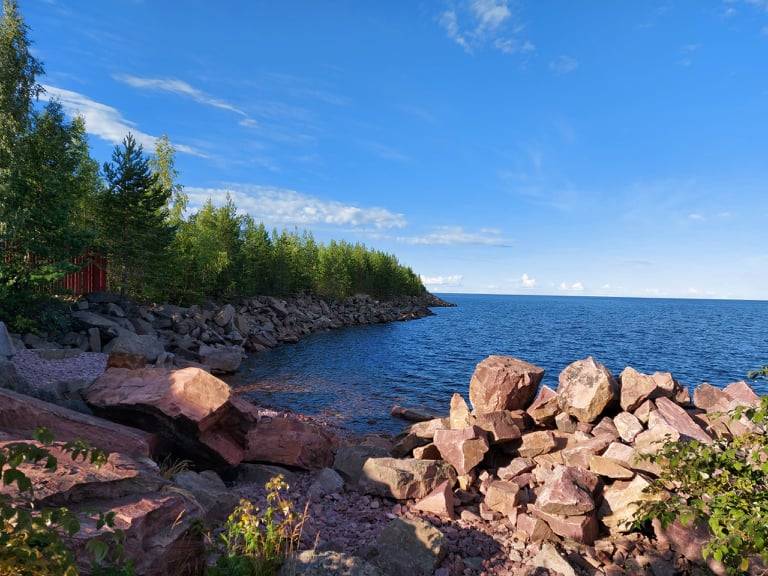

Raspberry quartzite near Lake Onega in Karelia, 2021
In the Soviet period, diabase and quartzite were used not only for decorations but also for industrial purposes, for example, in the production of enamel. Veps connections to the mining industry were widely promoted in the Soviet time, as they were seen as a symbol of Veps’ rapid integration in the new industrial society. After the fall of the Soviet Union, due to financial difficulties of the 1990s, state mining enterprises were partly closed, partly sold to private owners. The raspberry quartzite extraction almost stopped and is now managed by a small-scale private enterprise. Diabase extraction is maintained by several private companies of different sizes. Throughout the Soviet time and in the post-Soviet period, mining quarries of diabase and quartzite remained primary employment sources in Veps villages.
Many interviewees express their growing concerns about private companies “wasting” local stone for graveyard monuments and for appropriating Veps resources without investing back in the villages. The common complaint expressed in the interviews is that diabase and quartzite are now managed by unknown quarry directors, most of them being not from Karelia.
When speaking about their perceptions of stoneworking in Veps villages, my interviewees expressed, at times, polarized points of view. Whereas some of them would complain that they “feel suffocated” by the stone and the owners of private mining quarries, others would praise the stone for “giving life to the villages.” Both these expressions, even though seemingly very different, illustrate the vital role of stone in Veps villages. Many of my interviewees speak of diabase and quartzite emotionally, complimenting their extreme firmness, durability, or bright colors. They often treat mining as a family occupation connecting their labor to the work performed by their parents or grandparents. While praising diabase and quartzite, they at the same time feel proud and accomplished as the producers of a valuable resource much needed both as a decoration and as an industrial element.
Alongside these affective attitudes towards diabase and quartzite, darker and more bitter feelings also emerge. Many interviewees express their growing concerns about private companies “wasting” local stone for graveyard monuments and for appropriating Veps resources without investing back in the villages. The common complaint expressed in the interviews is that diabase and quartzite are now managed by unknown quarry directors, most of them being not from Karelia. The residents are also worried that the stone is carried away from the region to obscure places. The present situation offers a radical contrast with Soviet-time promotion of diabase and quartzite’s elite status. As the demand for the local stone is falling, many miners feel that their labor is less valued and needed as well. They struggle with deepening alienation from the resource and, consequently, from their territory. This situation illustrates the strong connections between care and concern that often represent two sides of the same coin.
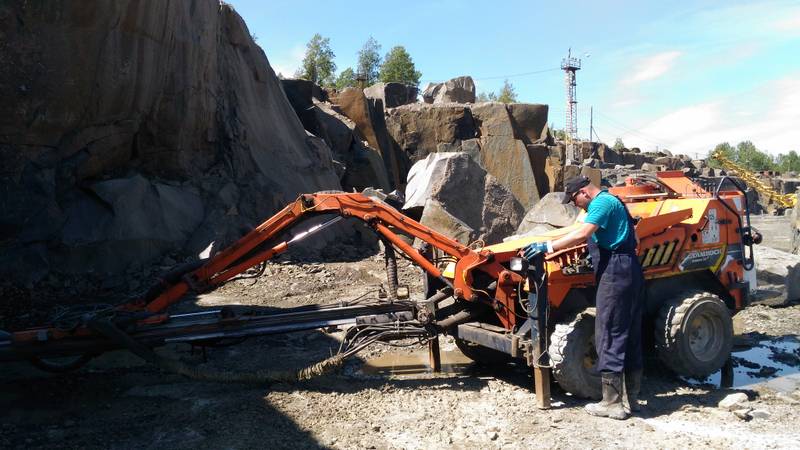

A drilling machine worker at the diabase quarry, 2021
Productive bodies and self-destruction
In the Soviet discourse, starting from the 1930s, workers’ productivity and the importance of labor remained a vital theme. The Soviet labor was viewed as a creative practice and as a strong opportunity for self-realization and personal growth. As many of my Veps interviewees were employed at mining quarries in the Soviet period, labor productivity is a crucial value for many of them, even when reached through self-sacrifice. In this sense, their value and appreciation of the mining industry and the stone they produce may turn into destructive care. Alongside extending the realm of care towards mining materials and machines, the workers experience a lack of self-care towards their bodies.
In many cases, miners’ perceptions of the work’s impact on their health are characterized by a distracted, estranged attitude. Many of them talk readily about the negative consequences of stoneworking, the illnesses resulting from breathing stone dust or loading heavy diabase pieces. Nevertheless, they also stress that these illnesses are an unavoidable side effect of the work that had to be done. A common conclusion for such narratives is “well, we did what we needed to do” or “work is work, you know.”
Several interviews mention that, while working, they were often ignoring the safety measures as following the rules would prevent them from reaching better results. Therefore, they were not wearing masks securing them from stone dust or goggles protecting their eyes. As the workers note, it was too hot to work while wearing a mask and they managed to produce less, so many of them chose not to follow the instructions. When loading the stone for transportation, some mining workers chose not to wear protective gloves and loaded diabase with bare hands. When speaking about such occasions, the miners note the harmful effects of the industry, but simultaneously express pride in their bodies’ strength and self-endurance.
By overcoming bodily limits, the workers re-establish their identities as skilled masters producing valuable resources. However, as a result, their bodily care is often not viewed as valuable unless it is connected to the industry’s well-being and higher productivity. As they become attached to mining industries, they simultaneously experience emotional detachment from their bodies and feelings. Moreover, due to positive emotional attitudes towards the industry, the workers are less keen to notice detrimental environmental effects of mining such as dust in the air or poorer water quality in the nearby lake. As the mining industry’s vital role in the life cycles of Veps villages is widely acknowledged, its potential damaging impacts are often viewed as inescapable side effects of a crucial task.
Concluding remarks
The notion of destructive care brings attention to the potentially harmful and detrimental effects of caring attitudes in industrial settings. While Veps workers deeply care about the stone they produce, this care harms their bodies and life spans. In this way, workers and materials form a complex tensioned symbiosis of simultaneous attachment and struggle. As state discourses promote self-sacrifice and going beyond one’s limits, the miners tend to choose work results over bodily well-being.
The case of Veps miners is instrumental for our understanding of uneven power relations in the world of care. In this example, human-industry relations are still strongly formed by Soviet-time industrial discourses proclaiming the sacrality and high value of labor. Therefore, the lack of self-care expressed by mining workers could be viewed as a result of state power translated by industrial enterprises. At the same time, I suggest that it is also a sign of workers’ agency. When Veps workers develop their emotional relations with stone and industry, they establish their identities and proclaim their knowledge of the local resource. However, as they build new connections with industry, they lose the most intimate bonds with their own bodies and with the landscape. As we discuss care in more-than-human worlds, it is crucial to keep in mind the potential darker effects of caring relations: what if, by expanding our connections of care, we simultaneously lose other vital ties?
